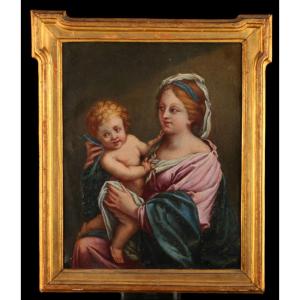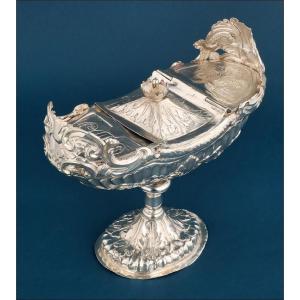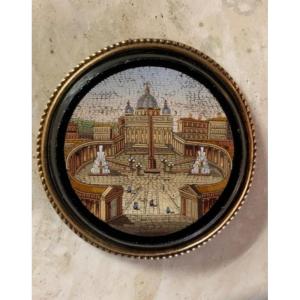This specific iconographic theme the attentive dog the symbolic butterfly and the burning altar is a recurrent motif in the artist’s workshop. Variations of this scene appear on other plates preserved in European collections attributed to or signed by the artist. The deep cobalt blue background applied in finely ground glass paste without visible joints further supports the attribution as it is a known feature of Raffaelli’s mosaics from 1785 to 1810. The perimeter border featuring occhi di pernice typical white tesserae with black centers is also commonly seen in his works whether on framed panels loose plaques or luxurious snuffboxes.
What truly elevates this piece to the rank of a masterpiece is its exceptional technical quality. The glass filati tesserae are microscopically cut and assembled with incredible patience. Some areas feature tesserae as small as 0.2 mm arranged in tonal gradients to convey volume shading and texture the muscle folds of the dog the speckled wings of the butterfly the smoke rising from the brazier. These light transitions are imperceptible from a distance but reveal great complexity under magnification.
The scene evokes themes of loyalty transience and sacrifice. The butterfly symbolizing the soul or fleeting desire appears drawn to the flame while the dog a symbol of fidelity watches silently. A fitting allegory of late Roman Neoclassicism.
The piece shows a light patina on the metal reverse confirming its age and some superficial wear consistent with time that far from detracting adds authenticity. It is preserved intact with no visible loss of tesserae which is exceptional for micromosaics of this period. An outstanding addition to any Grand Tour collection.
A rare opportunity to acquire a museum-grade artwork.
Dimensions: 6 cm (2.36 in).
History of Giacomo Raffaelli
Giacomo Raffaelli Rome 1753–1836 was one of the most influential figures in Roman micromosaic art and a pioneer in transforming this traditional technique into a refined autonomous art form. Trained in the Vatican mosaic tradition he applied the same precision and meticulous craftsmanship of sacred art to secular and luxury items winning the favor of European collectors nobility and Grand Tour travelers.
In 1775 Raffaelli was appointed Mosaicist of the Vatican placing him at the center of an elite network of artistic and diplomatic connections. His work which includes plaques paintings decorated furniture jewelry and personal items is known for its uncompromising technique use of finely drawn glass filati absolute mastery of chromatic gradients balanced compositions and expert color application. He introduced the characteristic occhi di pernice border around 1785 which became a hallmark of his style.
His Roman workshop became a must-visit stop for cultured travelers seeking to take home a piece of classical-inspired art. He also completed commissions for the Napoleonic court and various European royal families. His most celebrated works include Roman vistas allegories animals flowers and symbolic scenes.
Raffaelli was also innovative in his use of materials employing not only tinned copper but also slate marble and portable plaques. Most of his works are unsigned but can be securely attributed through their technique color palette and recurring motifs. Today his legacy lives on in prestigious collections including the Vatican Museums the Louvre the Wallace Collection and the Grand Tour Museum in Brighton.
His workshop was continued by his son Vincenzo although none of the later productions matched the technical level of Giacomo’s works. His contributions to micromosaic art marked a turning point in the history of European decorative collecting.












































 Le Magazine de PROANTIC
Le Magazine de PROANTIC TRÉSORS Magazine
TRÉSORS Magazine Rivista Artiquariato
Rivista Artiquariato